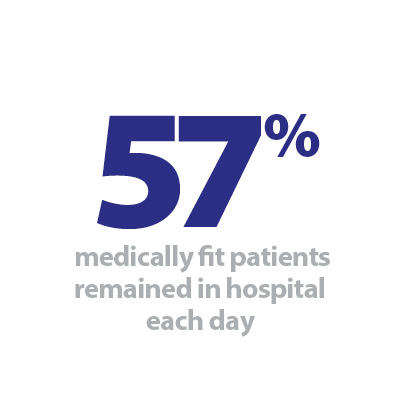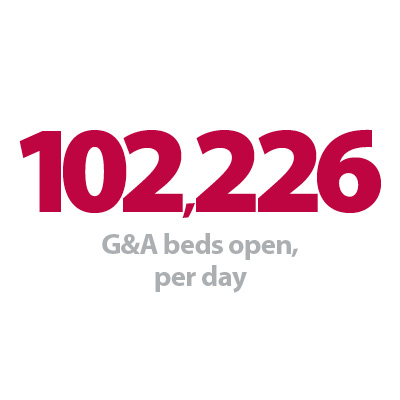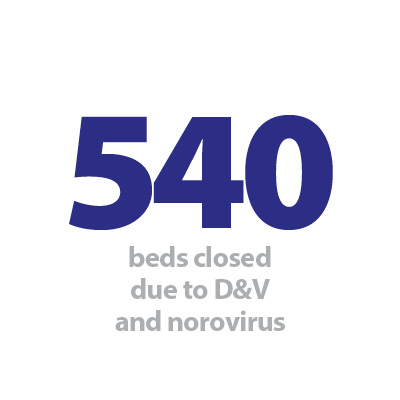


Introduction
Today NHS England published another release of its weekly winter situation reports, alongside the monthly performance and activity statistics. These offer a snapshot of activity across emergency care and hospitals, and insight into trust performance.
This week's winter data (1-7 January) continue to highlight the pressures of seasonal illnesses as we see more hospital beds being taken up by patients with flu, norovirus and Covid-19. Patient flow is also a cause for concern, with a high proportion of patients remaining in hospital despite being medically fit for discharge.
However, the data also shows some improvements with fewer hours being lost due to ambulance handover delays compared to the same point last year, despite more patients arriving by ambulance. This continues to demonstrate how staff are tirelessly working to provide patients with the best possible care in difficult circumstances.
Monthly activity and performance statistics provide useful context to the state of the sector. Key points to highlight include:
Ambulance activity: The number of category 1 and category 2 incidents increased in December 2023 compared to the month before. Average response times for category 1 and category 2 incidents deteriorated in the latest month, both missing the NHS national targets.
Emergency care activity: A&E attendances and emergency admissions increased slightly in December. A&E performance targets were not met again this month and the number of patients waiting more than 12 hours from decision to admit to admission has increased by 2.8%.
Elective care: Activity increased across the board in November and the waiting list fell by 1.2%, although this remains high at 7.6m. The number of those waiting more than 78 weeks has increased again this month, but those waiting longer than 52 weeks has fallen.
Diagnostics: Activity has seen improvement in November, with over 2.3m diagnostic tests carried out, the highest month on record. However, in the last month, the waiting list increased to 1.6m.
Cancer: November saw an increase in activity for the 28-day faster diagnosis standard, as well as an improvement in performance, with a higher proportion of patients told an outcome of their cancer diagnosis within 28 days of an urgent GP referral for suspected cancer.
Urgent community response: As of October 2023, 84.5% of urgent community response referrals met the two-hour standard for delivery.
Mental health: November 2023 saw a rise in referrals, but the number of people in contact and the waiting list for adult and children and young people mental health services also remains high.
Winter situation report (1-7 January)
A&E closures and diverts: There were no A&E closures this week. There were a total of 28 A&E diverts this week, eight more than the week prior and five more than the same week last year.
Ambulance arrivals: A total of 91,234 patients arrived by ambulance, a decrease of 2.5% since last week.
Ambulance handovers: 30.9% of ambulance handovers were delayed by 30 minutes or more, up from 28.9%. 13.4% were delayed by 60 minutes or more, up from 11.7%. The total hours lost to ambulance handover delays fell to 28,872 hours.
Critical care: Adult critical care bed occupancy is at 79.6% this week, an increase from 74.9%.
Diarrhoea and vomiting (D&V): The number of beds closed due to D&V and norovirus increased this week with an average of 540 beds closed per day, up from 486 last week.
Discharges: An average of 21,748 patients each day no longer met the criteria to reside. Compared to last week, a smaller proportion of patients remained in hospital this week at 57.3%.
Flu: This week the average number of general and acute beds occupied by flu patients each day was at 1,441, an increase of 17%. An average of 107 critical care beds were occupied by flu patients each day this week (33% more than the week before).
General and acute (G&A) beds: An average of 102,206 G&A beds were open each day across all acute trusts. A daily average of 67 G&A beds were unavailable and void to non-Covid infections. Bed occupancy increased from 89.5% over Christmas week to 93.2% in the first week of January.
Long stay: The number of patients staying in hospital longer than seven, 14, and 21 days all increased this week (up by 9.4%, 10.3%, and 10.9%, respectively).
Neonatal intensive care beds: Bed occupancy decreased slightly from last week to 68.2%; down from 68.8%. The average number of care beds open is at 1,720, an increase of two beds in the last week.
Paediatric and adolescent intensive care beds: Bed occupancy increased slightly this week to 76.9%, up from 76.5%. The average number of care beds open this week remained at 365, the same level as last week.
Respiratory syncytial virus (RSV): An average of 54 beds were closed this week due to RSV symptoms; two more beds compared to the previous week.
Staff absences: There were an average of 50,402 total absences each day this week, of which 5% were Covid-19 related (2,679). The total number of staff absences increased from the week before (47,779) but the proportion of Covid-19 related absences was the same.
Our view
The data released today continue to show the intensity of the seasonal pressures and increased demand during the tough winter period.
The weekly figures show that in the first week of the year trusts had to contend with more patients in hospital with flu, norovirus and Covid-19, undoubtedly putting pressure on services. The figures show a slight improvement in patient flow; this remains a cause of concern, as over 57% of patients remained in hospital despite being medically fit to be discharged. G&A bed occupancy also remains concerningly high at 93.2%, posing yet another challenge for trusts.
The monthly performance data are also testament to how hard staff work, as we see a fall in the elective care waiting list within the context of the longest industrial action in NHS history, rising staff absences and workforce shortages. We also see improvements in diagnostic activity with a record high number of diagnostic tests being carried out in November.
Today's data show the immense pressures currently facing trusts and suggest more tough times are ahead. This, more than ever, demonstrates the urgent need for a resolution to ongoing industrial action, so trusts and staff can continue to tackle care backlogs and provide patients with the care they need throughout this difficult winter period and beyond.